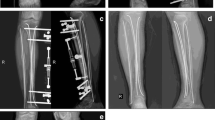Abstract
Background
Minimally invasive percutaneous plate fixation (MIPPF) has gained wide acceptance for treating periarticular fractures of the tibia. Despite the theoretical biological advantages of MIPPF, it is unclear whether these are offset by wound complications, union rate, and malalignment.
Questions/purposes
We therefore estimated the rate of union in tibial fractures treated by MIPPF, the rate of major and minor wound complications, occurrence of malunion, and level of function.
Methods
We retrospectively reviewed 80 patients with tibia fractures treated by MIPPF. Mean age of patients was 43 years (range, 18–74 years); there were 54 male and 26 female patients. Severe soft tissue injuries were seen in 16 patients. Patients were examined clinically for soft tissue condition, ROM, alignment, and determination of function (Lower Extremity Functional Score). Radiographs and CT were obtained to determine union and malunion. The minimum followup was 12 months (mean, 23 months; range, 12–48 months).
Results
Sixty-three patients (79%) had uneventful healing of the fractures. We identified minor wound complications in seven patients (9%). Delayed union occurred in three (4%) and nonunion in seven (9%); noticeable axial malalignment occurred in five (6%), whereas rotational deformities greater than 10° were revealed with the use of CT in 25% of cases.
Conclusions
MIPPF allowed uneventful healing and restoration of the preinjury level of function in most patients. However, complications occurred in a substantial number of patients, which needs attention when planning surgery.
Level of Evidence
Level IV, therapeutic study. See Guidelines for Authors for a complete description of levels of evidence.

Similar content being viewed by others
References
Babst R, Khong K. Minimally invasive surgery. In: Rüedi TP, Buckley RE, Moran CG, eds. AO Principles of Fracture Management. Stuttgart, Germany; New York, NY, USA: Thieme; 2007:199–212.
Binkley JM, Stratford PW, Lott SA, Riddle DL. The Lower Extremity Functional Scale (LEFS): scale development, measurement properties, and clinical application. North American Orthopaedic Rehabilitation Research Network. Phys Ther. 1999;79:371–383.
Borg T, Larsson S, Lindsjo U. Percutaneous plating of distal tibia fractures. Preliminary results in 21 patients. Injury. 2004;35:608–614.
Buckley R, Mohanty K, Malish D. Lower limb malrotation following MIPO technique of distal femur and proximal tibial fractures. Injury. 2011;42:194–199.
Collinge C, Sanders R, DiPasquale T. Treatment of complex tibial periarticular fractures using percutaneous technique. Clin Orthop Relat Res. 2000;375:69–77.
Dindo D, Demartines N, Clavien P. Classification of surgical complications. Ann Surg. 2004;240:205–213.
Gupta RK, Rohilla RK, Sangwan K, Singh V, Walia S. Locking plate fixation in distal metaphyseal tibial fractures: series of 79 patients. Int Orthop. 2010;34:1285–1290.
Gustilo RB, Anderson JT. Prevention of infection in the treatment of one thousand and twenty five open fractures of long bones: retrospective and prospective analyses. J Bone Joint Surg Am. 1976;58:453–458.
Hasenboehler E, Rikli D, Babst R. Locking compression plate with minimally invasive plate osteosynthesis in diaphyseal and distal tibial fracture: a retrospective study of 32 patients. Injury. 2007;38:365–370.
Horan TC, Gaynes RP, Martone WJ, Jarvis WR, Emori TG. CDC definitions of nosocomial surgical site infections, 1992: a modification of CDC definitions of surgical wound infections. Infect Control Hosp Epidemiol. 1992;13:606–608.
Lau TW, Leung F, Chan CF, Chow SP. Wound complication of minimally invasive plate osteosynthesis in distal tibia fractures. Int Orthop. 2008;32:697–703.
Maffulli N, Toms A, McMurtie A, Oliva F. Percutaneous plating of distal tibial fractures. Int Orthop. 2004;28:159–162.
Müller ME, Nazarian S, Koch P, Schatzker J, Heim U. The Comprehensive Classification of Fractures of Long Bones. Berlin, Heidelberg, Germany; New York, NY, USA: Springer-Verlag; 1990.
Nikolaou V, Efstathopoulos N, Papakostidis C, Kanakaris N, Giannoudis P. Minimally invasive plate osteosynthesis—an update. Curr Orthop. 2008;22:202–207.
Paley D, Herzenberg JE, Tetsworth K, McKie J, Bhave A. Deformity planning for frontal and sagittal plane corrective osteotomies. Orthop Clin North Am. 1994;25:425–465.
Redfern DJ, Syed SU, Davies SJM. Fractures of the distal tibia: minimal invasive plate osteosynthesis. Injury. 2004;35:615–620.
Ronga M, Longo UG, Mafilli N. Minimally invasive locked plating of distal tibia fractures is safe and effective. Clin Orthop Relat Res. 2010;468:975–982.
Strecker W, Popp D, Keppler P. Torsional deformities following intramedullary nailing of femur and tibia. Osteo Trauma Care. 2004;12:215–218.
Tscherne H, Gotzen L. Fractures With Soft Tissue Injuries. Berlin, Heidelberg, Germany; New York, NY, USA: Springer-Verlag; 1984.
Willenegger H, Roth B. [Treatment tactics and late results in early infection following osteosynthesis] [in German]. Unfallchirurgie. 1986;12:241–246.
Williams T, Schenk W. Bridging-minimally invasive locking plate osteosynthesis (Bridging-MILPO): technique description with prospective series of 20 tibial fractures. Injury. 2008;39:1198–1203.
Acknowledgments
We thank N. Zhizhko-Mikhasevich, MD, and I. Somova, MD, for assisting in calculation of rotational deformities.
Author information
Authors and Affiliations
Corresponding author
Additional information
Each author certifies that he or she, or a member of his or her immediate family, has no funding or commercial associations (eg, consultancies, stock ownership, equity interest, patent/licensing arrangements, etc) that might pose a conflict of interest in connection with the submitted article.
All ICMJE Conflict of Interest Forms for authors and Clinical Orthopaedics and Related Research editors and board members are on file with the publication and can be viewed on request.
Each author certifies that his or her institution approved the human protocol for this investigation, that all investigations were conducted in conformity with ethical principles of research, and that informed consent for participation in the study was obtained.
About this article
Cite this article
Sitnik, A.A., Beletsky, A.V. Minimally Invasive Percutaneous Plate Fixation of Tibia Fractures: Results in 80 Patients. Clin Orthop Relat Res 471, 2783–2789 (2013). https://doi.org/10.1007/s11999-013-2841-x
Published:
Issue Date:
DOI: https://doi.org/10.1007/s11999-013-2841-x




